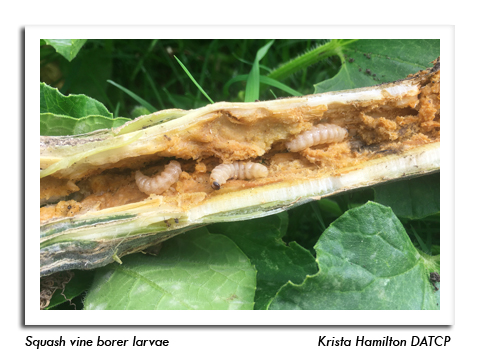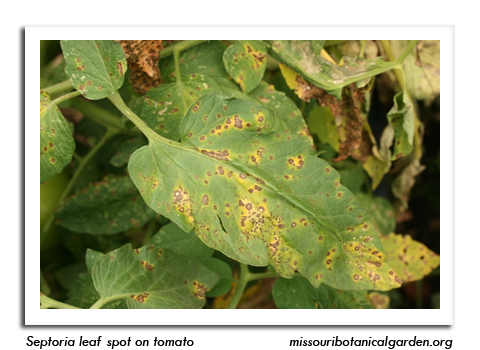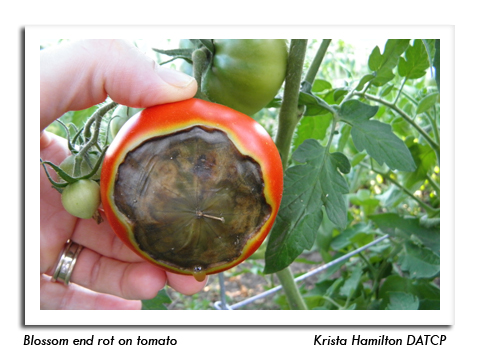
 |
|
|
Vegetables
Volume 63 Number 13 Date 07/26/2018 STRIPED CUCUMBER BEETLE - Adults were observed this week at the low rate of 2-5 per 20 plants on Dane and Rock County vegetable farms. This insect has been scarce this season, but growers of cucurbits should continue to monitor plants for beetles and signs of bacterial wilt, as populations are likely to increase next month. Control is justified for infestations of one beetle per plant in cucumbers and young pumpkins, and five beetles per plant in watermelon and squash. SQUASH VINE BORER - Damage to the stems of pumpkins and squash has become more pronounced as larvae approach maturity. Squash vine borer (SVB) larvae in the La Crosse area of western Wisconsin are full grown and will likely pupate by early August. Cultural control advised for SVB include destroying vines after harvest to prevent borers still in the larval stage from completing development. Fields that have been attacked in the past are most likely to have SVB problems in the future. SEPTORIA LEAF SPOT - Tomato plants in Dane and Pierce counties were recently diagnosed by the UW Plant Disease Clinic with this common fungal disease. Symptoms are small, circular yellow spots that first appear on the undersides of older, lower leaves after fruit set. As the spots mature, they turn brown or gray and enlarge to about 1 /4 inch in diameter. In the center of the spots are many black fruiting bodies called pycnidia, which cause secondary infections, generally progressing upward on the plant. Heavily infected leaves turn yellow and drop prematurely, leaving fruits exposed and more susceptible to sunscald. Cultural controls include a one-year rotation out of tomato, staking plants to promote air flow, applying mulch around the base of plants to minimize water splash, and eliminating sources of inoculum in the field by removing or destroying tomato debris by deep plowing immediately after harvest. SQUASH BUG - Home gardeners are reporting increasing squash bug populations on cucumber, summer squash and zucchini. The simplest control is to remove the bugs (eggs, nymphs, and adults) from plants and submerge the bugs in a bucket of soapy water. Growers are also advised to dispose of all dead foliage and other plant material that can harbor large numbers of nymphs. BLOSSOM END ROT - This relatively common garden problem is appearing as tomatoes ripen. The dark, water-soaked spot that starts at the blossom end of the fruit and enlarges around the fruit surface is caused by calcium imbalance and fluctuations in soil moisture. Blossom-end rot is most common when the growing season begins wet and later becomes dry when fruit is setting. Fungicides and insecticides are not an effective control for this physiological disorder. Maintaining consistent soil moisture levels throughout the growing season is important for reducing its occurrence. During periods of dry weather, watering thoroughly once or twice each week to moisten the soil to a depth of six inches is advised. IMPORTED CABBAGEWORM - Moths are still very common around home gardens, indicating the potential for damaging larval populations in August. Egg deposition on cole crops is expected to intensify in the next 1-2 weeks. Scouting is recommended through harvest. JAPANESE BEETLE - Surveys of vegetable gardens and farms in Columbia, Dane and Rock counties found beetles 1-35 per 20 plants, with an average of 12 beetles per 20 plants. As is the case for squash bugs and many other garden pest, physical removal of Japanese beetles is the preferred option for small gardens and plantings. The best time to handpick beetles is in the evening and early morning, when the beetles are less active. Pheromone traps attract beetles more beetles than they catch and should not be used as a form of control. CORN EARWORM - Counts have been very low at less than 13 moths per trap per week since migrants began arriving in the state during the first week of July. This suggests that the primary migration has not yet begun. -- Krista Hamilton, DATCP Entomologist 




|
|
|